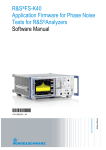Download Model 572A Spectroscopy Amplifier Operating and Service Manual
Transcript
Model 572A
Spectroscopy Amplifier
Operating and Service Manual
Printed in U.S.A.
ORTEC® Part No. 785100
Manual Revision D
0904
Advanced Measurement Technology, Inc.
a/k/a/ ORTEC®, a subsidiary of AMETEK®, Inc.
WARRANTY
ORTEC* warrants that the items will be delivered free from defects in material or workmanship. ORTEC makes
no other warranties, express or implied, and specifically NO WARRANTY OF MERCHANTABILITY OR
FITNESS FOR A PARTICULAR PURPOSE.
ORTEC’s exclusive liability is limited to repairing or replacing at ORTEC’s option, items found by ORTEC to be
defective in workmanship or materials within one year from the date of delivery. ORTEC’s liability on any claim
of any kind, including negligence, loss, or damages arising out of, connected with, or from the performance or
breach thereof, or from the manufacture, sale, delivery, resale, repair, or use of any item or services covered
by this agreement or purchase order, shall in no case exceed the price allocable to the item or service furnished
or any part thereof that gives rise to the claim. In the event ORTEC fails to manufacture or deliver items called
for in this agreement or purchase order, ORTEC’s exclusive liability and buyer’s exclusive remedy shall be
release of the buyer from the obligation to pay the purchase price. In no event shall ORTEC be liable for special
or consequential damages.
Quality Control
Before being approved for shipment, each ORTEC instrument must pass a stringent set of quality control tests
designed to expose any flaws in materials or workmanship. Permanent records of these tests are maintained
for use in warranty repair and as a source of statistical information for design improvements.
Repair Service
If it becomes necessary to return this instrument for repair, it is essential that Customer Services be contacted
in advance of its return so that a Return Authorization Number can be assigned to the unit. Also, ORTEC must
be informed, either in writing, by telephone [(865) 482-4411] or by facsimile transmission [(865) 483-2133], of
the nature of the fault of the instrument being returned and of the model, serial, and revision ("Rev" on rear
panel) numbers. Failure to do so may cause unnecessary delays in getting the unit repaired. The ORTEC
standard procedure requires that instruments returned for repair pass the same quality control tests that are
used for new-production instruments. Instruments that are returned should be packed so that they will withstand
normal transit handling and must be shipped PREPAID via Air Parcel Post or United Parcel Service to the
designated ORTEC repair center. The address label and the package should include the Return Authorization
Number assigned. Instruments being returned that are damaged in transit due to inadequate packing will be
repaired at the sender's expense, and it will be the sender's responsibility to make claim with the shipper.
Instruments not in warranty should follow the same procedure and ORTEC will provide a quotation.
Damage in Transit
Shipments should be examined immediately upon receipt for evidence of external or concealed damage. The
carrier making delivery should be notified immediately of any such damage, since the carrier is normally liable
for damage in shipment. Packing materials, waybills, and other such documentation should be preserved in
order to establish claims. After such notification to the carrier, please notify ORTEC of the circumstances so
that assistance can be provided in making damage claims and in providing replacement equipment, if
necessary.
Copyright © 2004, Advanced Measurement Technology, Inc. All rights reserved.
*ORTEC® is a registered trademark of Advanced Measurement Technology, Inc. All other trademarks used herein are
the property of their respective owners.
iii
CONTENTS
WARRANTY . . . . . . . . . . . . . . . . . . . . . . . . . . . . . . . . . . . . . . . . . . . . . . . . . . . . . . . . . . . . . . . . . . . . . . . . . . ii
SAFETY INSTRUCTIONS AND SYMBOLS . . . . . . . . . . . . . . . . . . . . . . . . . . . . . . . . . . . . . . . . . . . . . . . . . . iv
SAFETY WARNINGS AND CLEANING INSTRUCTIONS . . . . . . . . . . . . . . . . . . . . . . . . . . . . . . . . . . . . . . . v
1. DESCRIPTION . . . . . . . . . . . . . . . . . . . . . . . . . . . . . . . . . . . . . . . . . . . . . . . . . . . . . . . . . . . . . . . . . . . . . .
1.1. GENERAL . . . . . . . . . . . . . . . . . . . . . . . . . . . . . . . . . . . . . . . . . . . . . . . . . . . . . . . . . . . . . . . . . . . .
1.2. POLE-ZERO CANCELLATION . . . . . . . . . . . . . . . . . . . . . . . . . . . . . . . . . . . . . . . . . . . . . . . . . . .
1.3. ACTIVE FILTER . . . . . . . . . . . . . . . . . . . . . . . . . . . . . . . . . . . . . . . . . . . . . . . . . . . . . . . . . . . . . . .
1
1
1
2
2. SPECIFICATIONS . . . . . . . . . . . . . . . . . . . . . . . . . . . . . . . . . . . . . . . . . . . . . . . . . . . . . . . . . . . . . . . . . . .
2.1. PERFORMANCE . . . . . . . . . . . . . . . . . . . . . . . . . . . . . . . . . . . . . . . . . . . . . . . . . . . . . . . . . . . . . .
2.2. CONTROLS . . . . . . . . . . . . . . . . . . . . . . . . . . . . . . . . . . . . . . . . . . . . . . . . . . . . . . . . . . . . . . . . . .
2.3. INPUT . . . . . . . . . . . . . . . . . . . . . . . . . . . . . . . . . . . . . . . . . . . . . . . . . . . . . . . . . . . . . . . . . . . . . . .
2.4. OUTPUTS . . . . . . . . . . . . . . . . . . . . . . . . . . . . . . . . . . . . . . . . . . . . . . . . . . . . . . . . . . . . . . . . . . . .
2.5. ELECTRICAL AND MECHANICAL . . . . . . . . . . . . . . . . . . . . . . . . . . . . . . . . . . . . . . . . . . . . . . . .
4
4
5
5
5
5
3. INSTALLATION . . . . . . . . . . . . . . . . . . . . . . . . . . . . . . . . . . . . . . . . . . . . . . . . . . . . . . . . . . . . . . . . . . . . .
3.1. GENERAL . . . . . . . . . . . . . . . . . . . . . . . . . . . . . . . . . . . . . . . . . . . . . . . . . . . . . . . . . . . . . . . . . . . .
3.2. CONNECTION TO POWER . . . . . . . . . . . . . . . . . . . . . . . . . . . . . . . . . . . . . . . . . . . . . . . . . . . . . .
3.3. CONNECTION TO PREAMPLIFIER . . . . . . . . . . . . . . . . . . . . . . . . . . . . . . . . . . . . . . . . . . . . . . .
3.4. CONNECTION OF TEST PULSE GENERATOR . . . . . . . . . . . . . . . . . . . . . . . . . . . . . . . . . . . . .
3.5. SHAPING CONSIDERATIONS . . . . . . . . . . . . . . . . . . . . . . . . . . . . . . . . . . . . . . . . . . . . . . . . . . .
3.6. LINEAR OUTPUT CONNECTIONS AND TERMINATING CONSIDERATIONS . . . . . . . . . . . . .
3.7. SHORTING OR OVERLOADING THE AMPLIFIER OUTPUTS . . . . . . . . . . . . . . . . . . . . . . . . . .
3.8. INHIBIT OUTPUT CONNECTION . . . . . . . . . . . . . . . . . . . . . . . . . . . . . . . . . . . . . . . . . . . . . . . . .
3.9. BUSY OUTPUT CONNECTION . . . . . . . . . . . . . . . . . . . . . . . . . . . . . . . . . . . . . . . . . . . . . . . . . . .
3.10. CRM OUTPUT CONNECTION . . . . . . . . . . . . . . . . . . . . . . . . . . . . . . . . . . . . . . . . . . . . . . . . . .
6
6
6
6
6
7
7
8
8
8
8
4. OPERATING INSTRUCTIONS . . . . . . . . . . . . . . . . . . . . . . . . . . . . . . . . . . . . . . . . . . . . . . . . . . . . . . . . . 8
4.1. INITIAL TESTING AND OBSERVATION OF PULSE WAVEFORMS . . . . . . . . . . . . . . . . . . . . . . 8
4.2. FRONT PANEL CONTROLS . . . . . . . . . . . . . . . . . . . . . . . . . . . . . . . . . . . . . . . . . . . . . . . . . . . . . 8
4.3. FRONT PANEL CONNECTORS . . . . . . . . . . . . . . . . . . . . . . . . . . . . . . . . . . . . . . . . . . . . . . . . . . 9
4.4. REAR PANEL CONNECTORS . . . . . . . . . . . . . . . . . . . . . . . . . . . . . . . . . . . . . . . . . . . . . . . . . . 10
4.5. STANDARD SETUP PROCEDURE . . . . . . . . . . . . . . . . . . . . . . . . . . . . . . . . . . . . . . . . . . . . . . . 10
4.6. POLE-ZERO ADJUSTMENT . . . . . . . . . . . . . . . . . . . . . . . . . . . . . . . . . . . . . . . . . . . . . . . . . . . . 10
4.7. BLR THRESHOLD ADJUSTMENT . . . . . . . . . . . . . . . . . . . . . . . . . . . . . . . . . . . . . . . . . . . . . . . 11
4.8. OPERATION WITH SEMICONDUCTOR DETECTORS . . . . . . . . . . . . . . . . . . . . . . . . . . . . . . . 12
4.9. OPERATION IN SPECTROSCOPY SYSTEMS . . . . . . . . . . . . . . . . . . . . . . . . . . . . . . . . . . . . . 15
4.10. OTHER EXPERIMENTS . . . . . . . . . . . . . . . . . . . . . . . . . . . . . . . . . . . . . . . . . . . . . . . . . . . . . . 16
5. CIRCUIT DESCRIPTION . . . . . . . . . . . . . . . . . . . . . . . . . . . . . . . . . . . . . . . . . . . . . . . . . . . . . . . . . . . . . 19
6. MAINTENANCE . . . . . . . . . . . . . . . . . . . . . . . . . . . . . . . . . . . . . . . . . . . . . . . . . . . . . . . . . . . . . . . . . . . . 21
6.1. TEST EQUIPMENT REQUIRED . . . . . . . . . . . . . . . . . . . . . . . . . . . . . . . . . . . . . . . . . . . . . . . . . 21
6.2. PULSER TEST . . . . . . . . . . . . . . . . . . . . . . . . . . . . . . . . . . . . . . . . . . . . . . . . . . . . . . . . . . . . . . . 21
6.3. SUGGESTIONS FOR TROUBLESHOOTING . . . . . . . . . . . . . . . . . . . . . . . . . . . . . . . . . . . . . . 23
6.4. FACTORY REPAIR . . . . . . . . . . . . . . . . . . . . . . . . . . . . . . . . . . . . . . . . . . . . . . . . . . . . . . . . . . . 23
6.5. TABULATED TEST POINT VOLTAGES . . . . . . . . . . . . . . . . . . . . . . . . . . . . . . . . . . . . . . . . . . . 23
iv
SAFETY INSTRUCTIONS AND SYMBOLS
This manual contains up to three levels of safety instructions that must be observed in order to avoid
personal injury and/or damage to equipment or other property. These are:
DANGER
Indicates a hazard that could result in death or serious bodily harm if the safety instruction is
not observed.
WARNING
Indicates a hazard that could result in bodily harm if the safety instruction is not observed.
CAUTION
Indicates a hazard that could result in property damage if the safety instruction is not
observed.
Please read all safety instructions carefully and make sure you understand them fully before attempting to
use this product.
In addition, the following symbol may appear on the product:
ATTENTION – Refer to Manual
DANGER – High Voltage
Please read all safety instructions carefully and make sure you understand them fully before attempting to
use this product.
v
SAFETY WARNINGS AND CLEANING INSTRUCTIONS
DANGER Opening the cover of this instrument is likely to expose dangerous voltages. Disconnect the
instrument from all voltage sources while it is being opened.
WARNING Using this instrument in a manner not specified by the manufacturer may impair the
protection provided by the instrument.
Cleaning Instructions
To clean the instrument exterior:
! Unplug the instrument from the ac power supply.
! Remove loose dust on the outside of the instrument with a lint-free cloth.
! Remove remaining dirt with a lint-free cloth dampened in a general-purpose detergent and water
solution. Do not use abrasive cleaners.
CAUTION To prevent moisture inside of the instrument during external cleaning, use only enough liquid
to dampen the cloth or applicator.
! Allow the instrument to dry completely before reconnecting it to the power source.
vi
1
ORTEC MODEL 572A
SPECTROSCOPY PILE-UP AMPLIFIER
1. DESCRIPTION
1.1. GENERAL
The ORTEC 572A Spectroscopy Amplifier and
Pile-Up Rejector is a single-width NIM module with
a versatile combination of switch-selectable pulseshaping and output characteristics. It features
extremely low noise, wide gain range, and excellent
overload response for universal application in highresolution spectroscopy. It accepts input pulses of
either polarity that originate in germanium or silicon
semiconductor detectors, in scintillation counters
with either fast or slow scintillators, in proportional
counters, in pulsed ionization chambers, in electron
multipliers, etc.
The 572A has an input impedance of approximately
500Ω and accepts either positive or negative input
pulses with rise times <650 ns and fall times >40
µs. Six integrate and differentiate time constants
are switch-selectable to provide optimum shaping
for resolution and count rate. The first differentiation
network has variable pole-zero cancellation that
can be adjusted to match preamplifiers with decay
times >40 µs. The pole-zero cancellation drastically
reduces the undershoot after the first differentiator
and greatly improves overload and count rate
characteristics. In addition, the amplifier contains
an active filter shaping network that optimizes the
signal-to-noise ratio and minimizes the overall
resolving time. Both unipolar and bipolar outputs
are provided simultaneously on the front and rear
panels.
The unipolar output should be used for
spectroscopy when dc coupling can be maintained
from the 572A to the analyzer. A BLR (baseline
restorer) circuit is included in the 572A for improved
performance at all count rates. Baseline correction
is applied during intervals between input pulses
only and a front panel switch selects a discriminator
level to identify input pulses. The unipolar output dc
level can be adjusted in the range from -100 mV to
+100 mV. This output permits the use of the directcoupled input of the analyzer with a minimum
amount of interface problems. The 572A bipolar
output may be preferable for spectroscopy when
operating into an ac-coupled system at high
counting rates.
Internal pulse pileup (a second pulse arriving
before the first pulse has been completed) is
sensed internally. The 572A includes an Inhibit
output BNC connector on the rear panel that can be
used to inhibit measurement of the result of a pulse
pileup when it occurs.
The 572A can be used for constant-fraction timing
when operated in conjunction with an ORTEC 551
or 552 Timing Single-Channel Analyzer. The
ORTEC timing single-channel analyzers feature a
minimum of walk as a function of pulse amplitude
and incorporate a variable delay time on the output
pulse to enable the timing pickoff output to be
placed in time coincidence with other signals.
The 572A has complete provisions, including
power, for operating any ORTEC solid-state
preamplifier. Normally, the preamplifier pulses
should have a rise time of 0.25 µs or less to
properly match the amplifier filter network and a
decay time greater than 40 µs for proper pole-zero
cancellation. The 572A input impedance is 500Ω.
When long preamplifier cables are used, the cables
can be terminated in series at the preamplifier end
or in shunt at the amplifier end with the proper
resistors. The output impedance is about 0.1Ω at
the front panel connectors and 93Ω at the rear
panel connectors. The front panel outputs can be
connected to other equipment by a single cable
going to all equipment and shunt terminated at the
far end of the cabling. If series termination is
desired, the rear panel connectors can be used to
connect the 572A to other modules. See Section 3
for further information.
1.2. POLE-ZERO CANCELLATION
Pole-zero cancellation is a method for eliminating
pulse undershoot after the first differentiating
network. In an amplifier not using pole-zero
cancellation (Fig. 1.1), the exponential tail on the
preamplifier output signal (usually 50 to 500 µs)
2
causes an undershoot whose peak amplitude is
roughly determined from:
undershoot amplitude
differentiated pulse amplitude
=
differentiation time
preamplifier pulse decay time
For a 1-µs differentiation time constant and a 50-µs
preamplifier pulse decay time, the maximum
undershoot is 2% and this decays with a 50-µs time
constant. Under overload conditions, this
undershoot is often sufficiently large to saturate the
amplifier during a considerable portion of the
undershoot, causing excessive dead time. This
effect can be reduced by increasing the
preamplifier pulse decay time (which generally
reduces the counting rate capabilities of the
preamplifier) or compensating for the undershoot
by using pole-zero cancellation.
Pole-zero cancellation is accomplished by the
network shown in Fig. 1.2. The pole [s + (1/To)] due
to the preamplifier pulse decay time is canceled by
the zero of the network [s + (K/R C )]. In effect, the
dc path across the differentiation capacitor adds an
attenuated replica of the preamplifier pulse to just
cancel the negative undershoot of the
differentiating network.
2
1
Total preamplifier-amplifier pole-zero cancellation
requires that the preamplifier output pulse decay
time be a single exponential decay and matched to
the pole-zero-cancellation network. The variable
pole-zero-cancellation network allows accurate
cancellation for all preamplifiers having 40-µs or
greater decay times. Improper matching of the
pole-zero-cancellation network will degrade the
overload performance and cause excessive pileup
distortion at medium counting rates. Improper
matching causes either an under-compensation
(undershoot is not eliminated) or an overcompensation (output after the main pulse does not
return to the baseline and decays to the baseline
with the preamplifier time constant). The pole-zero
adjust is accessible from the front panel of the
572A and can easily be adjusted by observing the
baseline with an oscilloscope with a monoenergetic
source or pulser having the same decay time as the
preamplifier under overload conditions. The
adjustment should be made so that the pulse
returns to the baseline in the minimum time with no
undershoot.
1.3. ACTIVE FILTER
When only FET gate current and drain thermal
noise are considered, the best signal-to-noise ratio
occurs when the two noise contributions are equal
for a given input pulse shape. The Gaussian pulse
shape (Fig. 1.3) for this condition requires an
amplifier with a single RC differentiate and n equal
RC integrates where n approaches infinity.
The Laplace transform of this transfer function is:
s
1
(n 6 4)
G(s) '
×
s % (1/RC) [s % (1/RC)]n
where the first factor is the single differentiate and
the second factor is the n integrates. The 572A
active filter approximates this transfer function.
Figure 1.3 illustrates the results of pulse shaping in
an amplifier. Of the four pulse shapes shown the
cusp would produce minimum noise but is
impractical to achieve with normal electronic
circuitry and would be difficult to measure with an
ADC. The true Gaussian shape deteriorates the
signal-to-noise ratio by only about 12% from that of
the cusp and produces a signal that is easy to
measure, but requires many sections of integration
(n 6 4). With two sections of integration the
waveform identified as a Gaussian approximation
can be obtained, and this deteriorates the signal-tonoise ratio by about 22%. The ORTEC active filter
network in the 572A Amplifier provides the fourth
waveform in Fig. 1.3; this waveform has
characteristics superior to the Gaussian
approximation, yet obtains them with four complex
poles. By this method the output pulse shape has
a good signal-to-noise ratio, is easy to measure,
and yet requires only a practical amount of
electronic circuitry to achieve the desired results.
3
Fig. 1.1. Differentiation in an Amplifier Without Pole-Zero Cancellation.
Fig. 1.2. Differentiation in a Pole-Zero Canceled Amplifier.
4
Fig. 1.3. Pulse Shapes for Good Signal-to-Noise Ratios.
2. SPECIFICATIONS
2.1. PERFORMANCE
GAIN RANGE Continuously adjustable from X1
through X1500.
PULSE SHAPING Gaussian on all ranges with
peaking time equal to 2.2τ and pulse width at 0.1%
level equal to 2.9 times the peaking time.
INTEGRAL NONLINEARITY <0.05% (0.025%
typical) using 2 µs shaping.
NOISE <8 µV referred to the input (5 µV typical)
using 2 µs shaping and gain $100.
TEMPERATURE INSTABILITY
Gain #0.0075%/EC, 0 to 50EC.
DC Level <±50 µV/EC, 0 to 5OEC.
CROSSOVER WALK #±3 ns for 50:1 dynamic
range, including contribution of ORTEC 551 or 552
Constant-Fraction Timing Single-ChannelAnalyzer
using 50% fraction and 0.5 µs shaping.
COUNT RATE STABILITY The 1.33 MeV gamma
ray peak from a Co source, positioned at 85% of
analyzer range, typically shifts <0.024%, and its
FWHM broadens <16% when its incoming count
rate changes from 0 to 100000 counts/s using 2 µs
shaping. The amplifier will hold the baseline
reference up to count rates in excess of 150000
counts/s.
60
OVERLOAD RECOVERY Recovers to within 2%
of rated output from X300 overload in 2.5
nonoverloaded unipolar pulse widths, using
maximum gain; same recovery from X1000
overload for bipolar pulses.
5
2.2. CONTROLS
Ten-turn precision potentiometer for
continuously variable direct-reading gain factor of
X0.5 to X1.5.
GAIN
COARSE GAIN Six-position selector switch selects
feedback resistors for gain factors of 20, 50, 100,
200, 500, and 1 K.
INPUT ATTENUATOR Jumper on printed circuit
board selects an input attenuation factor of 1 or 10
(gain factor of X1 or X0.1).
POS/NEG Toggle switch selects input circuit for
either polarity of input pulses from the preamplifier.
SHAPING TIME Six-position switch selects time
constant for active filter network pulse shaping;
selections are 0.5, 1, 2, 3, 6, and 10 µs.
Potentiometer to adjust pole-zero
cancellation for decay times from 40 µs to 4.
Factory preset at 50 µs to match normal
characteristics of ORTEC preamplifiers.
PZ ADJ
BLR Toggle switch selects a source for the gated
baseline restorer discriminator threshold level from
one of three positions.
! Auto The BLR threshold is automatically set to
an optimum level as a function of the signal
noise level by an internal circuit. This allows
easy setup and very good performance under
most conditions.
! PZ Adj The BLR threshold is determined by the
threshold potentiometer. The BLR time constant
is greatly increased to facilitate PZ adjustment.
This position may give the lowest noise for
conditions of low count rate and/or longer
shaping times.
! Threshold The BLR threshold is set manually
by the threshold potentiometer. Range is 0 to
300 mV referred to the positive output signal.
The BLR time constant is the same as for the
Auto switch setting.
DC Screwdriver potentiometer adjusts the unipolar
output baseline dc level; range, +100 mV to
-100 mV.
2.3. INPUT
INPUT Type BNC front and rear panel connectors
accept either positive or negative pulses with rise
times in the range from 10 to 650 ns and decay
times from 40 to 2000 µs; Z -500Ω, dc coupled;
linear maximum, 1 V (10V with attenuator jumper
set at X0.1); absolute maximum, 20 V.
in
2.4. OUTPUTS
UNI Unipolar front panel BNC with Z , <1Ω and
rear panel BNC with Z = 93Ω. Short-circuit proof;
prompt; full-scale linear range 0 to +10 V; active
filter shaped and dc restored; dc level adjustable to
±100 mV.
in
in
Bi Bipolar front panel BNC with Z <10Ω and rear
panel BNC with Z = 93Ω. Short-circuit proof;
prompt output with positive lobe leading and linear
range of ±10V; active filter shaped.
in
in
BUSY Rear panel BNC with Z <10Ω provides a
+5 V logic pulse for the duration that the input pulse
exceeds the baseline restorer discriminator level.
Connect to the ORTEC MCA Busy input for dead
time correction.
in
INH Inhibit rear panel BNC with Z <10Ω provides
a nominal +5 V logic signal when an internal pulse
pileup occurs: width -6τ in coincidence with the
pileup; to be used for an MCA anticoincidence input
to prevent storage of pileup data in the spectrum.
in
CRM Count Ratemeter rear panel BNC furnishes
a nominal +5 V logic signal for every linear input
pulse; width, 300 ns; to be used as an input to a
ratemeter or counter.
PREAMP POWER Rear panel standard ORTEC
power connector; Amphenol 17-10090; mates with
captive and non-captive power cords on all
standard ORTEC preamplifiers.
2.5. ELECTRICAL AND MECHANICAL
POWER REQUIRED (not including any load on
the Preamp Power connector)
+24 V, 100 mA; -24 V, 105 mA;
+12 V, 85 mA; -12 V, 50 mA.
FRONT PANEL DIMENSIONS NIM-standard
single-width module (1.35 by 8.714 in.) per TID20893.
6
3. INSTALLATION
3.1. GENERAL
The 572A operates on power that must be
furnished from a NIM-standard bin and power
supply such as the ORTEC 4001/4002 Series. The
bin and power supply is designed for relay rack
mounting. If the equipment is to be rack mounted,
be sure that there is adequate ventilation to prevent
any localized heating of the components that are
used in the 572A. The temperature of equipment
mounted in racks can easily exceed the maximum
limit of 50EC unless precautions are taken.
3.2. CONNECTION TO POWER
The 572A contains no internal power supply and
must obtain the necessary dc operating power from
the bin and power supply in which it is installed for
operation. Always turn off power for the power
supply before inserting or removing any modules.
After all modules have been installed in the bin and
any preamplifiers have also been connected to the
Preamp Power connectors on the amplifiers, check
the dc voltage levels from the power supply to see
that they are not overloaded. The ORTEC
4001/4002 Series Bins and Power Supplies have
convenient test points on the power supply control
panel to permit monitoring these dc levels. If any
one or more of the dc levels indicates an overload,
some of the modules will need to be moved to
another bin to achieve operation.
3.3. CONNECTION TO PREAMPLIFIER
The preamplifier output signal is connected to the
572A through the appropriate Input BNC connector
on the front or rear panel. The input impedance is
about 500Ω and is dc-coupled to ground; therefore
the preamplifier output must be either ac-coupled or
have approximatelyzero dc voltage under no-signal
conditions.
The 572A incorporates pole-zero cancellation in
order to enhance the overload and count rate
characteristics of the amplifier. This technique
requires matching the network to the preamplifier
decay time constant in order to achieve perfect
compensation.Thepole-zero adjustment should be
set each time the preamplifier or the shaping time
constant of the amplifier is changed. For details of
the pole-zero adjustment see Section 4.6. An
alternate method is accomplished easily by using a
monoenergetic source and observing the amplifier
baseline with an oscilloscope after each pulse
under approximately X2 overload conditions.
Adjustment should be made so that the pulse
returns to the baseline in a minimum amount of
time with no undershoot.
Preamplifier power at +24 V, -24 V, +12 V, and
-12 V is available through the Preamp Power
connector on the rear panel. When the preamplifier
is connected, its power requirements are obtained
from the same bin and power supply as is used for
the amplifier, and this increases the dc loading on
each voltage level over and above the
requirements for the 572A at the module position in
the bin.
When the 572A is used with a remotely located
preamplifier (i.e., preamplifier-to-amplifier
connection through 25 ft or more of coaxial cable),
be careful to ensure that the characteristic
impedance of the transmission line from the
preamplifier output to the 572A input is matched.
Since the input impedance of the 572A is about
500Ω, sending-end termination will normally be
preferred; the transmission line should be seriesterminated at the preamplifier output. All ORTEC
preamplifiers contain series terminations that are
either 93Ω or variable; coaxial cable type RG-62/U
or RG-71/U is recommended.
3.4. CONNECTION OF TEST PULSE
GENERATOR
THROUGH A PREAMPLIFIER The satisfactory
connection of a test pulse generator such as the
ORTEC 419 Precision Pulse Generator or
equivalent depends primarily on two
considerations; the preamplifier must be properly
connected to the 572A as discussed in Section 3.3,
and the proper input signal simulation must be
applied to the preamplifier. To ensure proper input
signal simulation, refer to the instruction manual for
the particular preamplifier being used.
DIRECTLY INTO THE 572A Since the input of
the 572A has 500Ω of input impedance, the test
pulse generator will normally have to be terminated
at the amplifier input with an additional shunt
resistor. In addition, if the test pulse generator has
a dc offset, a large series isolating capacitor is also
required since the 572A input is dc coupled. The
ORTEC test pulse generators are designed for
7
direct connection. When any one of these units is
used, it should be terminated with a 100Ω
terminator at the amplifier input or be used with at
least one of the output attenuators set at In. (The
small error due to the finite input impedance of the
amplifier can normally be neglected.)
SPECIAL CONSIDERATIONS FOR POLE-ZERO
CANCELLATION When a tail pulser is connected
directly to the amplifier input, the PZ Adj should be
adjusted if overload tests are to be made (other
tests are not affected). See Section 4.6 for the polezero adjustment. If a preamplifier is used and a tail
pulser is connected to the preamplifier test input,
similar precautions are necessary. In this case the
effect of the pulser decay must be removed; i.e., a
step input should be simulated.
3.5. SHAPING CONSIDERATIONS
The shaping time constant on the 572A is switchselectable in steps of 0.5, 1, 2, 3, 6, and 10 µs. The
choice of the proper shaping time constant is
generally a compromise between operating at a
shorter time constant for accommodation of high
counting rates and operating with a longer time
constant for a better signal-to-noise ratio. For
scintillation counters the energy resolution depends
largely on the scintillator and photomultiplier, and
therefore a shaping time constant of about four
times the decay-time constant of the scintillator is a
reasonable choice (for Nal, a 1-µs shaping time
constant is about optimum). For gas proportional
counters the collection time is normally in the 0.5 to
5 µs range and a 2 µs or greater time constant
selection will generally give optimumresolution. For
surface barrier semiconductor detectors, a 0.5 to 2
µs resolving time will generally provide optimum
resolution. Shaping time for Ge(Li) detectors will
vary from 1 to 6 µs, depending on the size,
configuration, and collection time of the specific
detectorand preamplifier. When a charge-sensitive
preamplifier is used, the optimum shaping time
constant to minimize the noise of a system can be
determined by measuring the output noise of the
system and dividing it by the system gain. Since the
572A has almost constant gain for all shaping
modes, the optimum shaping can be determined by
measuring the output noise of the 572A with a
voltmeter as each shaping time constant is
selected.
The 572A provides both unipolar and bipolar
outputs. The unipolar output pulses should be used
in applications where the best signal-to-noise ratio
(resolution) is most important, such as highresolution spectroscopy using semiconductor
detectors. Use of the unipolar output with baseline
restoration will also give excellent resolution at high
counting rates. The bipolar output should be used
in high count rate systems when the analyzer
system is ac-coupled and noise, or resolution, is a
secondary consideration.
3.6. LINEAR OUTPUT CONNECTIONS
AND TERMINATING CONSIDERATIONS
Since the 572A unipolar output is normally used for
spectroscopy the 572A is designed with a great
amount of flexibility in order for the pulse to be
interfaced with an analyzer. A gated baseline
restorer (BLR) circuit is included in this output for
improved performance at all count rates. A switch
on the front panel permits the threshold for the
restorer gate to be determined automatically,
according to the input noise level, or manually, with
a screwdriver adjustment. The switch also has a
center PZ Adj setting that can be used to eliminate
the BLR effect when making pole-zeroadjustments.
The unipolar output dc level can be adjusted from
-0.1 to +0.1 V to set the zero intercept on the
analyzer when direct coupling is used. The bipolar
output, with a 0 to 10 V range, can be used for
crossover timing or may be preferred for
spectroscopy when operating into ac-coupled
systems at high counting rates. Typical system
block diagrams for a variety of experiments are
described in Section 4.
Three general methods of termination are used.
The simplest of these is shunt termination at the
receiving end of the cable. A second method is
series termination at the sending end. The third is
a combination of series and shunt termination,
where the cable impedance is matched both in
series at the sending end and in shunt at the
receiving end. The combination is most effective,
but this reduces the amount of signal strength at
the receiving end to 50% of that which is available
in the sending instrument.
To use shunt termination at the receiving end of the
cable, connect the <1Ω output of the 572A (on the
front panel) through 93Ω cable to the. input of the
receiving instrument. Then use a BNC tee
connector to attach both the interconnecting cable
and a 100Ω terminator at the input connector of the
8
receiving instrument. Since the input impedance of
the receiving instrument is normally 1000Ω or
more, the effective instrument input impedance with
the 100Ω terminator will be of the order of 93Ω and
this matches the cable impedance correctly.
For series termination use the 93Ω output of the
572A for the cable connection. Use 93Ω cable to
interconnect this into the input of the receiving
instrument. The 1000Ω (or more) normal input
impedance at the input connector represents an
essentially open circuit, and the series impedance
in the 572A now provides the proper termination for
the cable.
For the combination of series and shunt
termination, use the 93Ω output on the rear panel of
the 572A and use 93Ω cable. At the input for the
receiving instrument use a BNC tee to attach both
the signal cable and a 100Ω resistive terminator.
Note that the signal span at the receiving end of
this type of circuit will always be reduced to 50% of
the signal span furnished by the sending
instrument.
For customer convenience, ORTEC stocks the
proper terminators and BNC tees, or they can be
ordered from a variety of commercial sources.
3.7. SHORTING OR OVERLOADING THE
AMPLIFIER OUTPUTS
All outputs of the 572A are dc-coupled with an
output impedance of about 0.1Ω for the front panel
connectors and 93Ω for the rear panel connectors.
If the output is shorted with a direct short circuit the
output stage will limit the peak current of the output
so that the amplifier will not be harmed. When the
amplifier is terminated with 100Ω, the maximum
rate allowed to maintain the linear output is
[200000 cps/τ(µs)] x [10/V ,(V)].
o
3.8. INHIBIT OUTPUT CONNECTION
The Inhibit output on the rear panel is intended for
application at the anticoincidence input of the
Analyzer. An output pulse is generated through this
connector when a pulse pileup is sensed in the
572A, and the pulse can then be used to prevent
the Analyzer from measuring and storing a false
amplitude. The signal is dc-coupled and rises from
0 to about +5 V for a time equal to 6τ, starting when
a pileup occurs.
3.9. BUSY OUTPUT CONNECTION
The signal through the rear panel Busy output
connector rises from 0 to about +5 V at the onset of
each linear input Pulse. Its width is equal to the
time the input pulse amplitude exceeds the BLR
discriminator level, and is extended automatically
by the generation of an Inhibit output signal. It can
be used to provide MCA live-time correction, to
control the generation of input pulses, to observe
normal operation with an oscilloscope, or for any of
a variety of other applications. Its use is optional
and no termination is required if the output is not
being used.
3.10. CRM OUTPUT CONNECTION
One NIM-standard positive logic pulse is generated
to correspond to each linear input pulse into the
572A. The pulses are available through the CRM
(Count Rate Meter) output BNC on the rear panel
and are intended for use in a count rate meter or
counter to monitor the true input count rate into the
amplifier. Its use is optional and no termination is
required if the output is not being used.
4. OPERATING INSTRUCTIONS
4.1. INITIAL TESTING AND
OBSERVATION OF PULSE WAVEFORMS
Refer to Section 6 for information on testing
performance and observing waveforms at front
panel test points. Figure 4.1 shows some typical
unipolar and bipolar output waveforms.
4.2. FRONT PANEL CONTROLS
GAIN A coarse Gain switch and a Gain 10-turn
locking precision potentiometer selectandprecisely
adjust the gain factor for the amplification in the
572A. Switch settings are X20, 50, 100, 200, 500,
and 1000. Continuous fine gain range is from X0.5
to X1.5, using markings of 500 through 1500 dial
divisions. An internal jumper setting provides one
additional gain factor selection of either X1.0 or
X0.1. Collectively the range of gain can be set at
9
POS/NEG A toggle switch selects an input circuit
that accepts either polarity of pulses from the
preamplifier.
PZ ADJ A screwdriver control to set the pole-zero
cancellation to match the preamplifier pulse decay
characteristics. The range is from 40 µs to infinity.
DC A screwdriver control adjusts the dc baseline
level of the unipolar output in the range of -0.1 V to
+0.1 V.
SHAPING A 6-position switch selects equal
integrate and differentiate time constants to shape
the input pulses. Settings are 0.5, 1, 2, 3, 6, and
10 µs.
BLR A 3-position toggle switch controls the
operation of the internal baseline restorer (BLR)
circuit. The center setting of the switch is effectively
Off, and this permits adjustment of the PZ Adj
control without interference from the BLR circuit.
The Auto setting of the switch selects a circuit that
regulates the threshold of the BLR gate according
to the output noise level. The Threshold setting
permits manual control of the BLR gate threshold
using thescrewdriver control immediately below the
toggle switch.
4.3. FRONT PANEL CONNECTORS
INPUT Accepts input pulses to be shaped and/or
amplified by the 572A. Compatible characteristics;
positive or negative with rise time from 10 to 650
ns; decay time greater than 40 µs for proper polezero cancellation; input linear amplitude range 0 to
10 V, with a maximum limit of ±20 V. Input
impedance is approximately 500Ω.
UNI Provides a unipolar positive output with
characteristics that are related to input peak
amplitude, gain, shaping time constants, pole-zero
cancellation, and baseline stabilization. The dc
baseline level is adjustable for offset to ±0.1 V.
Output impedance through this connector is about
0.1 Ω, dc coupled. Linear range 0 to +10V.
Fig. 4.1. Typical Effects of Shaping-Time Selection on
Output Waveforms.
any level from X1.0 through X1500, using all three
of these controls.
BI Provides a bipolar pulse with positive lobe
leading and with characteristics that are related to
input peak amplitude, gain, and shaping time
constants. Timing is prompt with respect to the
input. Crossover walk of this output is less than 3
ns (see Specifications). Output impedance through
10
this connector is about 0.1 Ω. Linear range of 0 to
±10V.
4.4. REAR PANEL CONNECTORS
IN Bridged with front panel input connector for
optional use as an alternate input connection
location.
INH Provides an output signal to identify a pulse
pileup in the 572A. Connect it to the
anticoincidence input of the multichannel analyzer
to inhibit measurement and storage of false
amplitudes.
UNI Provides a unipolar positive output with the
same characteristics as described for the front
panel Uni connector; the output impedance through
this connector is 93Ω.
BI Provides a bipolar output with the same
characteristics as described for the front panel BI
connector; the output impedance through this
connector is 93Ω.
CRM Provides a NIM-standard (.+5 V) slow
positive logic output for each linear input pulse. The
output can be connected into a ratemeter or
counter to monitor the true input count rate for the
amplifier.
BUSY Provides a signal that rises to approximately
+5V for the time that the input pulse amplitude
exceeds the BLR discriminator level, which can be
controlled manually or automatically. The output
can be used to correct for live time in the ORTEC
MCA by connecting it to the MCA Busy input.
PREAMP Provides power connections from the bin
and power supply to the ORTEC preamplifier. The
dc levels include +24 V, -24 V, +12 V, and -12 V.
4.5. STANDARD SETUP PROCEDURE
a. Connect the detector, preamplifier, high voltage
power supply, and amplifier into a basic system and
connect the amplifier unipolar output to an
oscilloscope. Connect the preamplifier power cable
to the Preamp power connector on the rear panel of
the 572A. Turn on power in the Bin and Power
Supply and allow the electronics of the system to
warm up and stabilize.
b. Set the 572A controls initially as follows:
Shaping
Coarse Gain
Gain
Internal Jumper
BLR
Thresh
Pos/Neg
2 µs
50
1.000
X1.0
PZ Adj
Fully clockwise
Match preamplifier
output polarity
c. Use a Co calibration source, set about 25 cm
60
from the active face of the detector. The unipolar
output pulse from the 572A should be about 8 to
10 V, using a preamplifier with a conversion gain of
170 mV/MeV.
d. Readjust the Gain control so that the higher peak
from the Co source (1.33 MeV) provides an
amplifier output at about 9 V.
60
4.6. POLE-ZERO ADJUSTMENT
The pole-zero adjustment is extremely critical for
good performance at high count rates. This
adjustment should be checked carefully for the best
possible results.
USING Ge(Li) SYSTEM AND 60Co
a. Adjust the radiation source count rate between
2 kHz and 10 kHz.
b. Observe the unipolar output with an
oscilloscope. Adjust the PZ Adj control so that the
trailing edge of the pulses returns to the baseline
without overshoot or undershoot (see Fig. 4.2).
The oscilloscope used must be dc-coupled and
must not contribute distortion in the observed
waveforms. Oscilloscopes such as Tektronix 453,
454, 465, and 475 will overload for a 10-V signal
when the vertical sensitivity is less than 100
mV/cm. To prevent overloading the oscilloscope,
use the clamp circuit shown in Fig. 4.3.
USING SQUARE WAVE THROUGH
PREAMPLIFIER TEST INPUT
A more precise pole-zero adjustment in the 572A
can be obtained by using a square wave signal as
the input to the preamplifier. Many oscilloscopes
include a calibration output on the front panel and
this is a good source of square wave signals at a
frequency of about 1 kHz. The amplifier
differentiates the signal from the preamplifier so
11
compared as shown in Fig. 4.4 to achieve excellent
pole-zero cancellation.
Fig. 4.3. A Clamp Circuit that Can Be Used to Prevent
Overloading the Oscilloscope Input.
Use the following procedure:
a. Remove all radioactive sources from the vicinity
of the detector. Set up the system as for normal
operation, including detector bias.
b. Set the 572A controls as for normal operation;
this includes gain, shaping, and input polarity.
c. Connect the source of 1-kHz square waves
through an attenuator to the Test input of the
preamplifier. Adjust the attenuator so that the 572A
output amplitude is about 9 V.
d. Observe the unipolar output of the 572A with an
oscilloscope, triggered from the 572A Busy output.
Adjust the PZ Adj control for proper response
according to Fig. 4.4. Use the clamp circuit of
Fig. 4.3 to prevent overloading the oscilloscope
input.
Figure 4.4A shows the amplifier output as a series
of alternate positive and negative Gaussian pulses.
In the other three pictures of this figure the
oscilloscope was triggered to show both positive
andnegative pulses simultaneously.Thesepictures
show more detail to aid in proper adjustment.
4.7. BLR THRESHOLD ADJUSTMENT
Fig. 4.2. Typical Waveforms Illustrating Pole-Zero
Adjustment Effects; Oscilloscope Trigger, 572A Busy
Output; 60Co Source with 1.33-MeV Peak Adjusted -9 V;
Count Rate, 3 kHz; Shaping Time Constant, 2 µs.
that it generates output signals of alternate
polarities on the leading and trailing edges of the
square wave input signal, and these can be
After the amplifier gain and shaping have been
selected and the PZ Adj control has been set to
operate properly for the particular shaping time, the
BLR Thresh control can be used to establish the
correct discriminator threshold for the baseline
restorer circuit. Normally, the toggle switch can be
set at Auto and the threshold level will be set
automatically just above the noise level. If desired,
12
Fig. 4.4. Pole-Zero Adjustment Using a Square Wave Input to the Preamplifier.
the switch can be set at Threshold and the manual
control just below the switch can then be used to
select the level manually as follows:
output. Adjust the trigger level according to the
information in Fig. 4.5.
a. Remove all radioactive sources from the vicinity
If a ratemeter or counter-timer is available, it can be
connected to the Busy output and the threshold
level can then be adjusted for about 200 counts/s.
b. Set the BLR switch at Threshold and turn the
4.8. OPERATION WITH SEMICONDUCTOR
DETECTORS
of the detector. Set up the system as for normal
operation, including detector bias.
control fully clockwise, for 300 mV.
c. Observe the unipolar output on the 100mV/cm
scale of the oscilloscope, using 5 µs/cm horizontal
deflection. Trigger the oscilloscope with the Busy
output from the 572A.
d. Reduce the control setting until the baseline
discriminator begins to trigger on noise; this
corresponds to about 200 counts/s from the Busy
CALIBRATION OF TEST PULSER An ORTEC
419 Precision Pulse Generator, or equivalent, is
easily calibrated so that the maximum pulse height
dial reading (1000 divisions) is equivalent to a
10-MeV loss in a silicon radiation detector. The
procedure is as follows:
13
b. Allow excitation from a source of known energy
(for example, alpha particles) to fall on the detector.
c. Adjust the amplifier gain and the bias level of the
biased amplifier to give a suitable output pulse.
d. Set the pulser Pulse Height control at the energy
of the alpha particles striking the detector (for
example, set the dial at 547 divisions for a
5.47-MeV alpha particle energy).
e. Turn on the pulser and use its Normalize control
and attenuators to set the output due to the pulser
for the same pulse height as the pulse obtained in
step c. Lock the Normalize control and do not move
it again until recalibration is required.
The pulser is now calibrated; the Pulse Height dial
read directly in MeV if the number of dial divisions
is divided by 100.
AMPLIFIER NOISE AND RESOLUTION
MEASUREMENTS As shown in Fig. 4.6, a
preamplifier, amplifier, pulse generator,
oscilloscope, and wide-band rms voltmeter such as
the Hewlett-Packard 3400A are required for this
measurement. Connect a suitable capacitor to the
input to simulate the detector capacitance desired.
To obtain the resolution spread due to amplifier
noise:
Fig. 4.6. System for Measuring Amplifier and Detector
Noise Resolution.
a. Measure the rms noise voltage (E ) at the
amplifier output.
Fig. 4.5. BLR Threshold Variable Control Settings.
a. Connect the detector to be used to the
spectrometer system, i.e., preamplifier, main
amplifier, and biased amplifier.
rms
b. Turn on the 419 Precision Pulse Generator and
adjust the pulser output to any convenient readable
voltage, E , as determined by the oscilloscope.
o
The full width at half maximum (FWHM) resolution
spread due to amplifier noise is then:
14
N(FWHM) '
2.35 Erms Edial
Eo
where E is the pulser dial reading in MeV and
2.35 is the factor for rms to FWHM. For averageresponding voltmeters such as theHewlett-Packard
400D, the measured noise must be multiplied by
1.13 to calculate the rms noise.
dial
The resolution spread will depend on the total input
capacitance, since the capacitance degrades the
signal-to-noise ratio much faster than the noise.
DETECTOR NOISE-RESOLUTION
MEASUREMENTS
The measurement just
described can be made with a biased detector
instead of the external capacitor that would be used
to simulate detector capacitance. The resolution
spread will be larger because the detector
contributes both noise and capacitance to the input.
The detector noise-resolution spread can be
isolated from the amplifier noise spread if the
detector capacity is known, since:
(Ndet )2 % (Namp )2 ' (Ntotal )2
Fig. 4.7. Noise as a Function of Bias Voltage.
so that the energy is in a convenient channel of the
analyzer.
b. Calibrate the analyzer in keV per channel, using
the pulser; full scale on the pulser dial is 10 MeV
when calibrated as described above.
c. Obtain the amplifier noise-resolution spread by
measuring the FWHM of the pulser peak in the
spectrum.
where N is the total resolution spread and N is
the amplifier resolution spread when the detector is
replaced by its equivalent capacitance.
total
amp
The detector noise tends to increase with bias
voltage, but the detector capacitance decreases,
thus reducing the resolution spread. The overall
resolution spread will depend upon which effect is
dominant. Figure 4.7 shows curves of typical noiseresolution spread versus bias voltage, using data
from several ORTEC silicon surface-barrier
semiconductor radiation detectors.
AMPLIFIER NOISE-RESOLUTION
MEASUREMENTS USING MCA Probably the
most convenient method of making resolution
measurements is with a pulse height analyzer as
shown by the setup illustrated in Fig. 4.8.
The amplifier noise-resolution spread can be
measured directly with a pulse height analyzer and
the mercury pulser as follows:
a. Select the energy of interest with an ORTEC 419
Precision Pulse Generator. Set the amplifier gain
Fig. 4.8. System for Measuring Resolution with a Pulse
Height Analyzer.
The detector noise-resolution spread for a given
detector bias can be determined in the same
manner by connecting a detector to the preamplifier
input. The amplifier noise-resolution spread must
be subtracted as described in "Detector NoiseResolution Measurements." The detector noise will
vary with detector size and bias conditions and
possibly with ambient conditions.
15
CURRENT-VOLTAGE MEASUREMENTS FOR Si
and Ge DETECTORS The amplifier system is not
directly involved in semiconductor detector currentvoltage measurements, but the amplifier serves to
permit noise monitoring during the setup. The
detector noise measurement is a more sensitive
method than a current measurement of determining
the maximum detector voltage that should be used
because the noise increases more rapidly than the
reverse current at the onset of detector breakdown.
Make this measurement in the absence of a
source.
Figure 4.9 shows the setup required for currentvoltage measurements. An ORTEC 428 Bias
Supply is used as the voltage source. Bias voltage
should be applied slowly and reduced when noise
increases rapidly as a function of applied bias.
Figure 4.10 shows several typical current-voltage
curves for ORTEC silicon surface-barrier detectors.
Fig. 4.9 is preferable. The detector is grounded as
in normal operation and the microammeter is
connected to the current monitoring jack on the 428
Detector Bias Supply.
4.9. OPERATION IN SPECTROSCOPY
SYSTEMS
HIGH-RESOLUTION ALPHA-PARTICLE
SPECTROSCOPY SYSTEM The block diagram of
a high-resolution Spectroscopy system for
measuring natural alpha particle radiation is shown
in Fig. 4.11. Alpha-particle resolution is obtained in
the following manner:
a. Use appropriate amplifier gain. Accumulate the
alpha peak in the MCA.
b. Slowly increase the amplifier gain until the alpha
peak is spread over 5 to 10 channels.
c. Calibrate the analyzer in keV per channel using
the pulser and the known energy of the alpha peak
(see "Calibration of Test Pulser") or two known
energy alpha peaks.
d. Calculate the resolution by measuring the
number of channels at the FWHM level in the peak
and converting this to keV.
HIGH-RESOLUTION GAMMA SPECTROSCOPY
SYSTEM A high-resolution gamma spectroscopy
Fig. 4.9. System for Detector Current and Voltage
Measurements.
system block diagram is shown in Fig. 4.12. When
germanium detectors that are cooled by a liquid
nitrogen cryostat are used, it is possible to obtain
resolutions from about 1 keV FWHM up (depending
on the energy of the incident radiation and the size
and quality of the detector). Reasonable care is
required to obtain such results. So me guidelines
for obtaining optimum resolution are:
a. Keep interconnection capacities between the
detector and preamplitier to an absolute minimum
(no long cables).
b. Keep humidity low near the detector-preamplifier
junction.
Fig. 4.10. Silicon Detector Back Current vs Bias Voltage.
When it is possible to float the microammeter at the
detector bias voltage, the method of detector
current measurement shown by the dashed lines in
c. Operate the amplifier with the shaping time that
provides the best signal-to-noise ratio.
d. Operate at the highest allowable detector bias to
keep the input capacity low.
16
Fig. 4.11. System for High-Resolution Alpha-Particle Spectroscopy.
SCINTILLATION-COUNTER GAMMA
SPECTROSCOPY SYSTEMS The ORTEC 572A
can be used in scintillation-counter spectroscopy
systems as shown in Fig. 4.13. The amplifier
shaping time constants should be selected in the
region of 0.5 to 1 µs for NaI or plastic scintillators.
For scintillators having longer decay times, longer
time constants should be selected.
4.10. OTHER EXPERIMENTS
Block diagrams illustrating how the 572A and other
ORTEC modules can be used for experimental
setups for various other applications are shown in
Figs. 4.15 through 4.18.
X-RAY SPECTROSCOPY USING
PROPORTIONAL COUNTERS Space charge
effects in proportional counters, operated at high
gas amplification, tend to degrade the resolution
capabilities drastically at x-ray energies, even at
relatively low counting rates. By using a high-gain
low-noise amplifying system and lower gas
amplification, these effects can be reduced and a
considerable improvement in resolution can be
obtained. The block diagram in Fig. 4.14 shows a
system of this type. Analysis can be accomplished
by simultaneous acquisition of all data on a
multichannel analyzer or counting a region of
interest in a single-channel analyzer window with a
counter and timer or counting ratemeter.
Fig. 4.12. System for High-Resolution Gamma
Spectroscopy.
17
Fig. 4.13. Scintillation-Counter Gamma Spectroscopy
System.
Fig. 4.15. General System Arrangement for Gating Control.
Fig. 4.14. High-Resolution X-Ray Energy Analysis
System Using a Proportional Counter.
18
Fig. 4.16. Gamma-Ray Charged-Particle Coincidence Experiment.
Fig. 4.17. Gamma-Ray Pair Spectrometry.
19
Fig. 4.18. Gamma-Gamma Coincidence Experiment.
5. CIRCUIT DESCRIPTION
Figure 5.1 is a block diagram of the instrument.
Much of the circuitry in the 572A has been
designed to use ORTEC Hybrid circuits. This
advanced technology achieves an economical
high-density package with high reliability.
Figure 5.2 illustrates the relative timing of the
signals in the 572A. The solid-line waveforms show
a normal response to a single linear input signal
from the preamplifier without any pulse pileup. The
broken-line waveforms show the modifications that
occur when there is a pileup condition.
The input from the preamplifier is a step change
with a very long decay and this is repeated and
differentiated at test point TP3. The 572A output
that results from this input is shaped, rising to its
peak in 2τ, where τ is the selected time constant of
0.5, 1, 2, 3, 6, or 10 µs. The amplifier produces the
fast shaped pulse from the same preamplifier input
pulse, and this triggers discriminator IC12, set just
above the noise level. The discriminator response
triggers the CRM output signal. The discriminator
response also triggers the Busy output signal,
which has a duration of 6τ, equal to the duration of
the linear output signal. The Inhibit output remains
low in the absence of a second pulse from the
preamplifier.
Using the broken-line waveforms to show the
variations when there is a pulse pileup, the second
pulse arrives before the Busy output signal
recovers. The linear output signal is distorted by the
second pulse. The fast amplifier generates another
output that again triggers the discriminator to
produce another CRM output pulse and to update
the Busy output. Since the bistable for the Inhibit
output has been set by the first pulse, the Inhibit
output is generated, starting at the response to the
second pulse and extending through the 6τ updated
interval of the Busy output.
20
Fig. 5.1. Amplifier Block Diagram.
21
Fig. 5.2. Timing Relations in the 572A Amplifier and Pile-Up
Rejector.
6. MAINTENANCE
6.1. TEST EQUIPMENT REQUIRED
The following test equipment should be utilized to
adequately test the specifications of the 572A
Spectroscopy Amplifier:
1. ORTEC 419 Precision Pulse Generator or 448
Research Pulser.
Input Polarity
Shaping Time Constant
BLR
Variable control
Positive
1 µs
PZ Adj
Fully CW for 300 mV
a. Connect a positive pulser output to the 572A
2. Tektronix 547 Series Oscilloscope with a type
1A1 plug-in or equivalent.
input and adjust the pulser to obtain +10 V at the
572A Unipolar output. This should require an input
pulse of 6.6 mV, using a 100Ω terminator at the
input.
3. Hewlett-Packard 3400A RMS Voltmeter.
This should also be +10 V.
Coarse Gain
Gain
1See
6.2. PULSER TEST1
1K
1.5
IEEE Standards, No. 301-1976.
b. Measure the positive lobe of the Bipolar output.
c. Change the Input polarity switch to Neg and then
back to Pos while monitoring the outputs for a
polarity inversion.
22
d. Vary the DC Adj control on the front panel while
monitoring the Unipolar output. Ensure that the
baseline can be adjusted through a range of +0.1
to -0.1 V. Readjust the control for zero.
e. Recheck the output pulse amplitude and adjust
if necessary to set it at +10 V with maximum gain.
Decrease the Coarse Gain switch stepwise from 1K
to 20 and ensure that the output amplitude changes
by the appropriate amount for each step. Return
the Coarse Gain switch to 1K.
f. Decrease the Gain control from l.5 to 0.5 and
check to see that the output amplitude decreases
by a factor of 3. Return the Gain control to
maximum at 1.5.
g. With the Shaping switch set for l µs, measure the
time to the peak on the unipolar output pulse; this
should be 2.2 µs, for 2.2τ. Measure the time to
baseline crossover of the bipolar output; this should
be 2.8 µs for 2.8τ.
h. Change the Shaping switch to 0.5 through 10 µs
in turn. At each setting, check to see that the time
to the unipolar peak is 2.2τ and the time to the
bipolar crossover is 2.8τ. Return the switch to 1 µs.
OVERLOAD TESTS Start with maximum gain,
=2µs, and a +10 V output amplitude. Increase the
pulser output amplitude by X200 and observe that
the unipolar output returns to within 200 mV of the
baseline within 24 µs after the application of a
single pulse from the pulser. It will probably be
necessary to vary the PZ Adj control on the front
panel in order to cancel the pulser pole and
minimize the time required for return to the
baseline.
τ
Increase the pulser output amplitude to 1000 times
the setting that provided the original +10 V output
amplitude from the 572A. Observe that the bipolar
output returns to within 200 mV of the baseline
within 26 µs after the application of a single pulse
from the pulser. It may be necessary to use
external control on the pulser to obtain the 6.6-V
output required for this test.
LINEARITY The integral nonlinearity of the 572A
can be measured by the technique shown in
Fig. 6.1. In effect, the negative pulser output is
subtracted from the positive amplifier output to
cause a null point that can be measured with
excellent sensitivity. The pulser output must be
Fig. 6.1. Circuit Used to Measure Nonlinearity.
varied between 0 and 10V, which usually requires
an external control source for the pulser. The
amplifier gain and the pulser attenuator must be
adjusted to measure 0 V at the null point when the
pulser output is 10 V. The variation in the null point
as the pulser is reduced gradually from 10 V to 0 V
is a measure of the nonlinearity. Since the
subtraction network also acts as a voltage divider,
this variation must be less than
(10 V full scale) x (±0.05% maximum nonlinearity)
x (1/2 for divider network) = ±2.5 mV
for the maximum null-point variation.
OUTPUT LOADING Use the test setup of Fig. 6.1.
Adjust the amplifier output to 10 V and observe the
null point when the front panel output is terminated
in 100Ω. The change should be less than 5 mV.
23
NOISE Measure the noise at the amplifier Unipolar
output with maximum amplifier gain and 2 µs
shaping time. Using a true rms voltmeter, the noise
should be less than 5 µV x 1500 (gain), or 7.5 mV.
For an average responding voltmeter, the noise
reading would have to be multiplied by 1.13 to
calculate the rms noise. The input must be
terminated in 100Ω during the noisemeasurements
6.3. SUGGESTIONS FOR
TROUBLESHOOTING
In situations where the 572A is suspected of a
malfunction, it is essential to verify such
malfunction in terms of simple pulse generator
impulses at the input. The 572A must be
disconnected from its position in any system, and
routine diagnostic analysis performed with a test
pulse generator and an oscilloscope. It is
imperative that testing not be performed with a
source and detector until the amplifier performs
satisfactorily with the test pulse generator.
The testing instructions in Section 6.2 and the
circuit descriptions in Section 5 should provide
assistance in locating the region of trouble and
repairing the malfunction. The two side plates can
be completely removed from the module to enable
oscilloscope and voltmeter observations.
6.4. FACTORY REPAIR
This instrument can be returned to the ORTEC
factory for service and repair at a nominal cost. Our
standard procedure for repair ensures the same
quality control and checkout that are used for a
new instrument.Alwayscontact Customer Services
at ORTEC, (865) 482-4411, before sending in an
instrument for repair to obtain shipping instructions
and so that the required Return Authorization
Number can be assigned to the unit. This number
should be marked on the address label and on the
package to ensure prompt attention when the unit
reaches the factory.
6.5. TABULATED TEST POINT VOLTAGES
The voltages given in Table 6.1 are intended to
indicate typical dc levels that can be measured on
the printed circuit board. In some cases the circuit
will perform satisfactorily even though, due to
component tolerances, there may be some voltage
measurements that differ slightly from the listed
values. Therefore the tabulated values should not
be interpreted as absolute voltages but are
intended to serve as an aid in troubleshooting.
Table 6.1. Typical dc Voltages
Note: All voltages measured with no input signal,
with the input terminated in 100Ω, and all controls
set fully clockwise at maximum.
Location
TP1
TP2
TP3
TP4
TP5
TP6
TP7
Q15E
Q16E
IC13 pin 2
Voltage
±5 mV
±30 mV
±20 mV
±20 mV
±30 mV
0 to +3.3 V
±6 mV
-15 V ±0.8 V
+15 V ±0.8 V
+5 V ±0.3 V
24
Bin/Module Connector Pin Assignments For Standard
Nuclear Instrument Modules per DOE/ER-0457T.
Pin Function
1
2
3
4
5
6
7
8
9
10
11
12
13
14
15
*16
*17
18
19
20
21
22
+3 V
-3V
Spare bus
Reserved bus
Coaxial
Coaxial
Coaxial
200 V dc
Spare
+6 V
-6V
Reserved bus
Spare
Spare
Reserved
+12 V
- 12 V
Spare bus
Reserved bus
Spare
Spare
Reserved
Pin Function
23
24
25
26
27
*28
*29
30
31
32
*33
*34
35
36
37
38
39
40
*41
*42
G
Reserved
Reserved
Reserved
Spare
Spare
+24 V
- 24 V
Spare bus
Spare
Spare
117 V ac (hot)
Power return ground
Reset (Scaler)
Gate
Reset (Auxiliary)
Coaxial
Coaxial
Coaxial
117 V ac (neutral)
High-quality ground
Ground guide pin
Pins marked (*) are installed and wired in ORTEC’s 4001A
and 4001C Modular System Bins.



















































